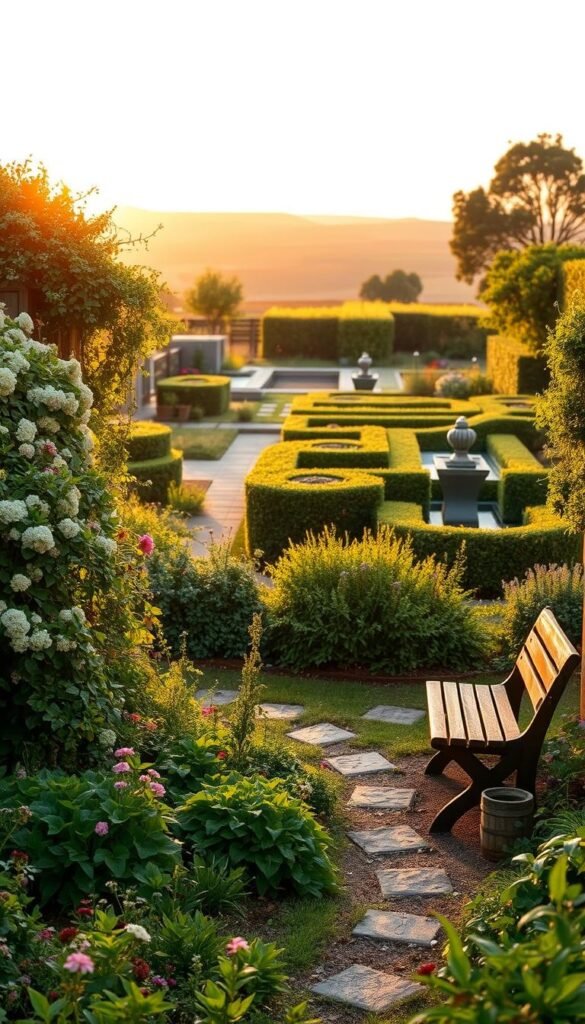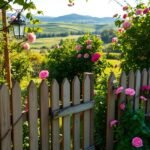Imagine stepping into a space where every plant tells a story. You might adore overflowing flower beds bursting with color, or prefer clean lines that whisper sophistication. Both approaches capture the essence of a beloved gardening tradition while offering distinct personalities.
Traditional designs feel like nature’s happy accident. Think winding stone paths framed by fragrant herbs and cheerful blooms. Vegetables mingle freely with roses, creating a playful tapestry that changes daily. This style celebrates spontaneity – perfect if you love surprises in your landscape.
Newer interpretations blend old-world magic with fresh perspectives. Picture bold color blocks of perennials swaying together, or ornamental grasses adding modern texture. These spaces maintain cozy appeal while introducing intentional structure, ideal for those wanting curated beauty with less upkeep.
We’ll explore how each approach handles plant selection, layout, and seasonal care. You’ll learn which style aligns with your maintenance preferences and design tastes. Ready to transform your yard into a personal paradise? Let’s dig into what makes these gardens unique – and how to choose your perfect match.
Understanding the Charm of Cottage Garden Styles
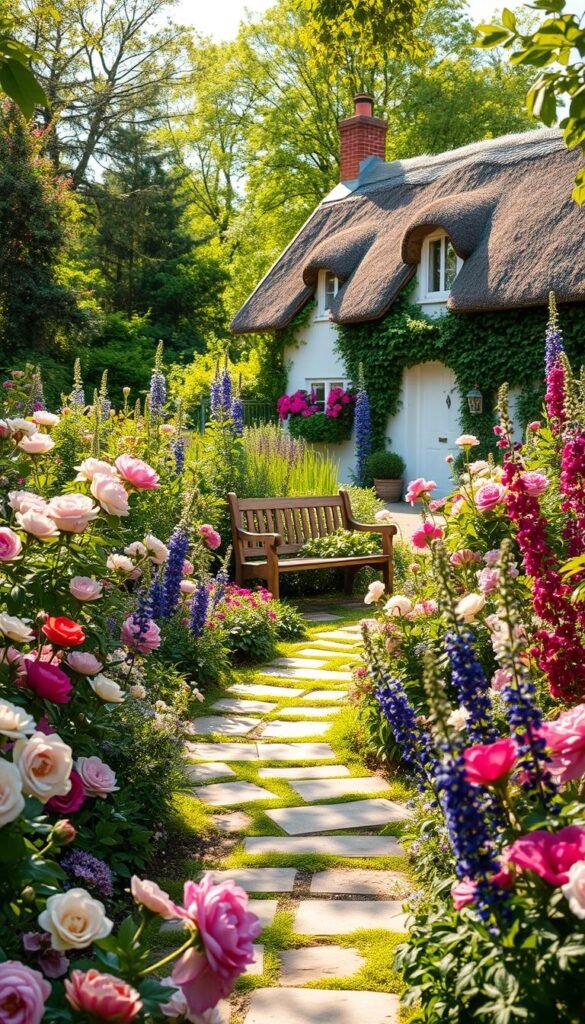
Step away from rigid rows and manicured hedges – these spaces thrive on joyful imperfection. At their core, cottage gardens celebrate life’s messy magic, where roses tumble over fences and basil brushes against zinnias. They’re living collages that blur the line between wild and cultivated.
What makes this style special? It’s the artful mix of textures and purposes. You’ll find lavender keeping company with tomatoes, while marigolds guard vegetable patches from pests. Winding gravel paths invite exploration, revealing new floral surprises at every turn.
The secret sauce? Planting “a little bit of a lot”. Instead of mass plantings, you’ll cluster small groups of diverse species. This creates:
- Constant color shifts as plants bloom in succession
- Natural pest control through companion planting
- Year-round visual drama from varied foliage
True charm lies in balancing beauty with function. Many enthusiasts blend old and new elements, like pairing heirloom roses with drought-tolerant grasses. For inspiration on mixing vintage and modern touches, explore creative combinations that maintain that timeless feel.
These gardens grow richer with time, developing personality as plants self-seed and mature. They’re not designed – they’re curated through seasons, always evolving yet forever cozy.
Defining the Traditional Country Cottage Garden
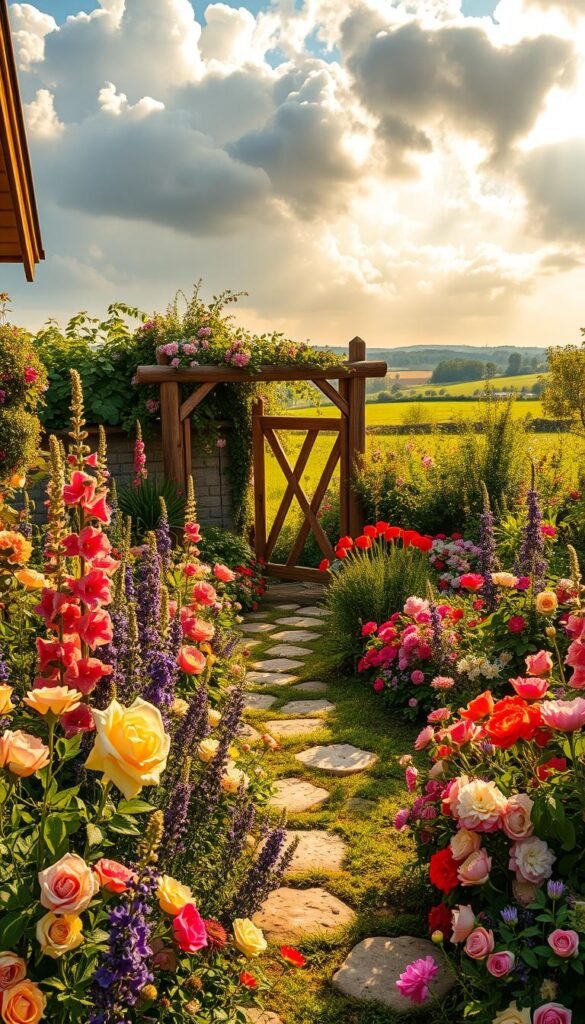
The heart of a traditional cottage garden beats with untamed beauty and purposeful chaos. These spaces master the art of looking effortlessly wild while hiding smart design choices beneath their floral frocks. Let’s uncover what makes this style endure through centuries.
Essential Characteristics and Plant Choices
Perennials rule here, forming about 70% of plantings in traditional cottage gardens for lasting structure. Favorites like peonies, lavender, and climbing roses return yearly, while annuals like cosmos add seasonal pops. You get continuous blooms from spring through frost, self-seeding surprises that keep the garden evolving, and less replanting work over time.
Whimsical Layouts and Dense Planting
Paths curve like lazy streams, inviting you to explore hidden nooks. Plants stack in three tiers for maximum impact while maintaining accessibility. This clever approach ensures every specimen gets its moment in the sun:
| Layer | Height Range | Star Players |
|---|---|---|
| Front Row | 6-18″ | Thyme, sweet alyssum |
| Mid-Level | 2-4′ | Foxglove, Shasta daisies |
| Backstage | 5-8′ | Hollyhocks, delphiniums |
Dense planting creates lush layers without overcrowding. You’ll enjoy riotous color combinations that feel intentional yet spontaneous – like nature designed them herself.
Discovering the Modern Cottage Garden Aesthetic
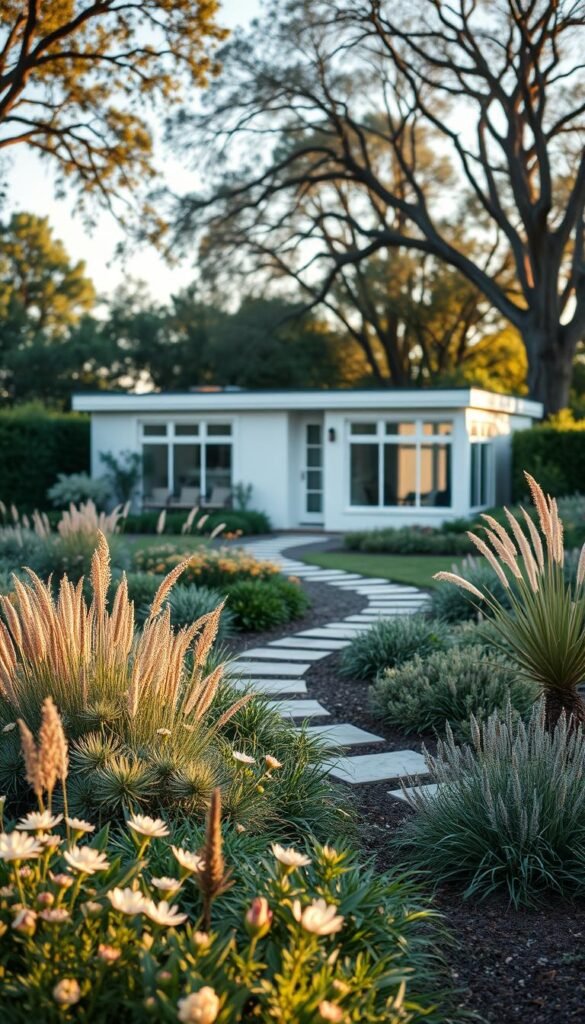
Picture a space where time-honored charm meets today’s design sensibilities. Today’s interpretations keep the free-spirited essence of classic designs while adding fresh twists. This approach balances nostalgic appeal with practical updates that suit busy lifestyles.
Naturalistic Planting and Contemporary Drifts
Garden designers like Tim Pilgrim reimagine classic elements through intentional arrangements. Instead of random clusters, you’ll see swathes of lavender or echinacea flowing like living rivers. These curated groupings create rhythm while preserving organic movement.
Modern layouts use repetition to guide the eye. Planting 3-7 specimens together forms bold statements without losing softness. This technique works beautifully with:
| Traditional Approach | Modern Update |
|---|---|
| Mixed-color annuals | Monochromatic drifts |
| Scattered herbs | Edible borders |
| Single specimen shrubs | Architectural grasses |
Color coordination takes center stage. You might pair purple salvias with silver-toned artemisia for subtle contrast. Ornamental grasses add winter interest, their feathery plumes catching frost like nature’s jewelry.
This style keeps maintenance manageable. Larger plant blocks mean fewer species to manage, while strategic repetition creates visual impact. It’s perfect for those wanting curated beauty that still feels welcoming and alive.
Key Elements of Traditional Cottage Garden Design
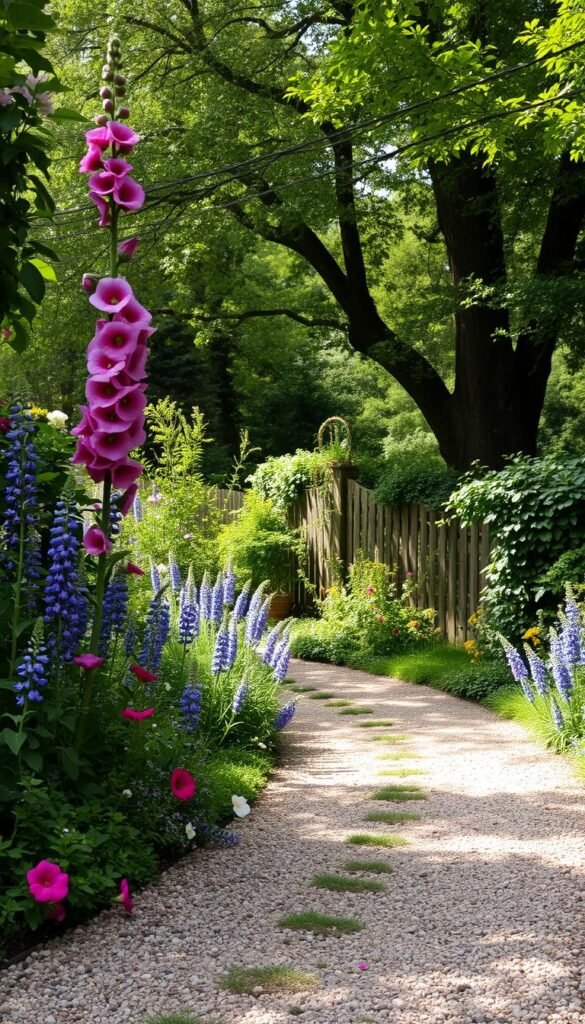
Unlock the secrets of timeless garden magic where every curve tells a story. Traditional designs balance wild beauty with smart planning, creating spaces that feel both effortless and intentional.
Curvy Paths and Seasonal Blooms
Winding walkways do more than guide your steps – they shape the garden’s personality. Gentle curves soften straight edges and create hidden pockets for surprises. These meandering routes help plants thrive by creating sheltered spots and sunny stretches.
Seasonal color unfolds like chapters in a favorite book. Snowdrops peek through late-winter soil, followed by tulips and peonies. By midsummer, roses and lavender take center stage, while autumn brings golden asters and crimson chrysanthemums.
Herbs, Edibles, and Ornamental Mix
Traditional designs blend beauty with practicality. You’ll find rosemary spilling onto gravel paths and calendula brightening vegetable patches. This mix attracts pollinators while filling your kitchen with fresh flavors.
Try these combinations for multi-purpose charm:
- Thyme creeping between stepping stones
- Foxgloves towering over salad greens
- Chamomile hugging the base of climbing roses
For those drawn to cottagecore aesthetic, this approach offers endless opportunities to blend nostalgia with nature. Classic flowers like hollyhocks add vertical drama, while herbs keep the space smelling heavenly.
Innovative Features in Modern Cottage Garden Design
Modern cottage gardens reimagine tradition through clever design choices that balance ease with artistry. By blending durable materials and strategic planting, these spaces offer fresh takes on classic charm while simplifying maintenance.
Use of Natural Materials and Hardscape Accents
Today’s designs play with texture through unexpected elements. Corten steel edging creates crisp boundaries that rust into earthy tones, while chunky timber borders add rustic warmth. Informal sand paths wind through plantings, inviting exploration without overwhelming the senses.
Local stone becomes functional art in modern layouts. Try these combinations:
- Slate stepping stones through lavender drifts
- Fieldstone retaining walls doubling as seating
- Crushed granite pathways reflecting moonlight
Integrating Easier, ‘Safe’ Plants in Bold Blocks
Designer Tim Pilgrim’s 70/30 rule simplifies plant selection. Seventy percent of your garden features reliable performers like:
| Plant | Height | Season |
|---|---|---|
| Nepeta | 18″ | Spring-Fall |
| Verbena bonariensis | 4′ | Summer |
| Lamb’s Ears | 12″ | Year-round |
Cluster these in groups of three to seven along paths or borders. The repetition creates rhythm, while the remaining thirty percent lets you experiment with unique accents like tropical cannas or rare heirloom blooms.
Country Cottage Garden vs. Modern Cottage Garden: Which Is Right for You?
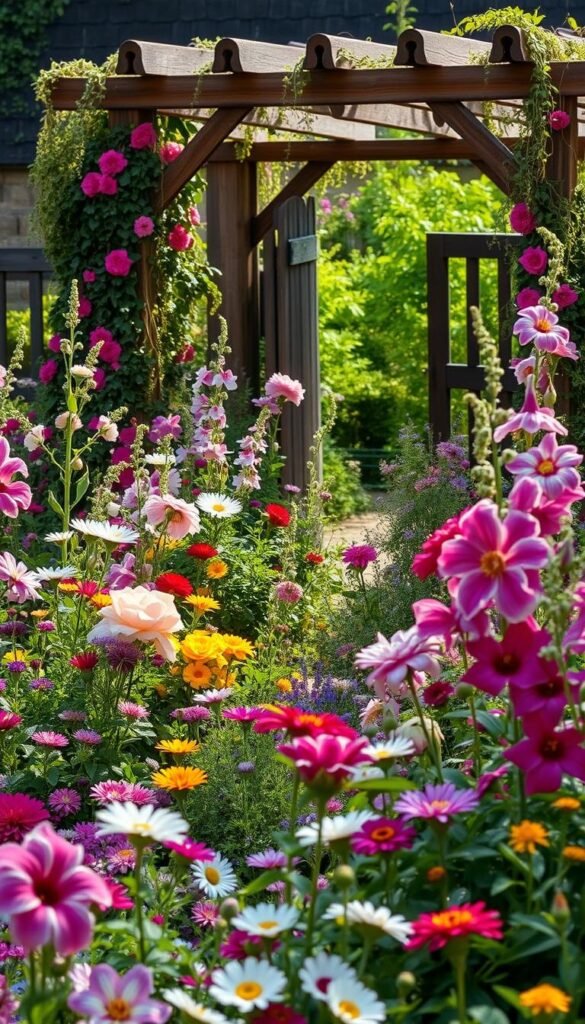
Your outdoor area should mirror your daily rhythm while sparking joy. Before diving into design choices, grab a notebook and observe how you interact with your surroundings. Do mornings find you sipping coffee while admiring blooms, or are weekends your only chance to tend to greenery?
Assessing Your Space and Preferences
Start by measuring your plot’s sunlight dance. Track how shadows move across your yard for three days. South-facing areas bake in full sun, while north corners stay cool and shaded. Match these microclimates to plant needs – lavender thrives in hot spots, while ferns prefer dappled light.
Ask yourself:
- Do I want fresh herbs at my fingertips?
- Should pathways accommodate wheelbarrows or strollers?
- Will I preserve heirloom seeds or try new hybrids?
Urban dwellers with limited areas might prefer space-maximizing vertical planters over sprawling flower beds. Remember: Your garden should solve problems, not create them.
Choosing Plants and Layouts That Fit Your Lifestyle
Compare these approaches to find your match:
| Design Element | Traditional | Modern |
|---|---|---|
| Layout | Free-form clusters | Geometric blocks |
| Plant Selection | 70% heritage varieties | 50% drought-tolerant species |
| Maintenance | Weekly deadheading | Biweekly checks |
| Aesthetic | Nostalgic charm | Clean elegance |
Busy professionals often lean toward modern layouts with self-sufficient plants like sedum or ornamental grasses. Weekend warriors might enjoy the hands-on creativity of traditional designs. Either way, let your garden grow with you – it’s okay to evolve your look as seasons change.
Planning and Designing Your Outdoor Space
Transform your landscape into a living masterpiece through thoughtful layout strategies. Begin with graph paper and colored pencils – simple tools that help visualize how shapes and textures will interact in your real-world oasis.
Mapping Out Curved Walkways and Plant Heights
Curved paths create natural flow while solving practical challenges. A 3-foot-wide gravel trail allows comfortable walking while leaving room for plants to spill over edges. Consider these elements when planning:
| Design Element | Practical Consideration |
|---|---|
| Path curvature | Allows wheelchair/stroller access |
| Border plants | 6-12″ height for visibility |
| Mid-level blooms | 2-3′ height for drama |
| Backdrop plants | 4-6′ height for structure |
Implement the “smallest to tallest” rule starting at path edges. Dwarf herbs like creeping thyme make fragrant borders, while foxgloves add vertical interest behind them. Leave 18 inches between plant groups for air circulation and growth space.
Your design should invite discovery. Place a rustic bench where paths bend, surrounded by fragrant jasmine or climbing roses. These pauses let visitors appreciate your plant combinations while providing convenient rest spots.
Blending Edible and Ornamental Garden Elements
Who says veggies can’t mingle with your blooms? The magic happens when ruby-red cherry tomatoes dangle beside fragrant roses, and basil leaves brush against zinnias. This approach turns your outdoor space into a living pantry bursting with color and flavor.
Snackable plants make gardening deliciously interactive. Tuck miniature cucumbers between cosmos, or let mint cascade over path edges. Kids love plucking sun-warmed strawberries hidden beneath nasturtium leaves. For refreshing summer drinks, grow lemon balm and holy basil – their leaves transform iced tea into herbal adventures.
There’s no rulebook here. Pair lavender with heirloom tomatoes for natural pest control, or let edible flowers like calendula brighten salads. Many plants pull double duty: yarrow attracts pollinators while its fern-like foliage adds texture. Discover more creative plant pairings that blur lines between supper and scenery.
Your home landscape thrives when edible and decorative elements collaborate. Marigolds shield veggies from pests, while rosemary’s upright form adds structure. This mix reduces maintenance by creating balanced ecosystems. Whether you prefer organized beds or wild arrangements, finding your style makes every harvest feel like a treasure hunt.

